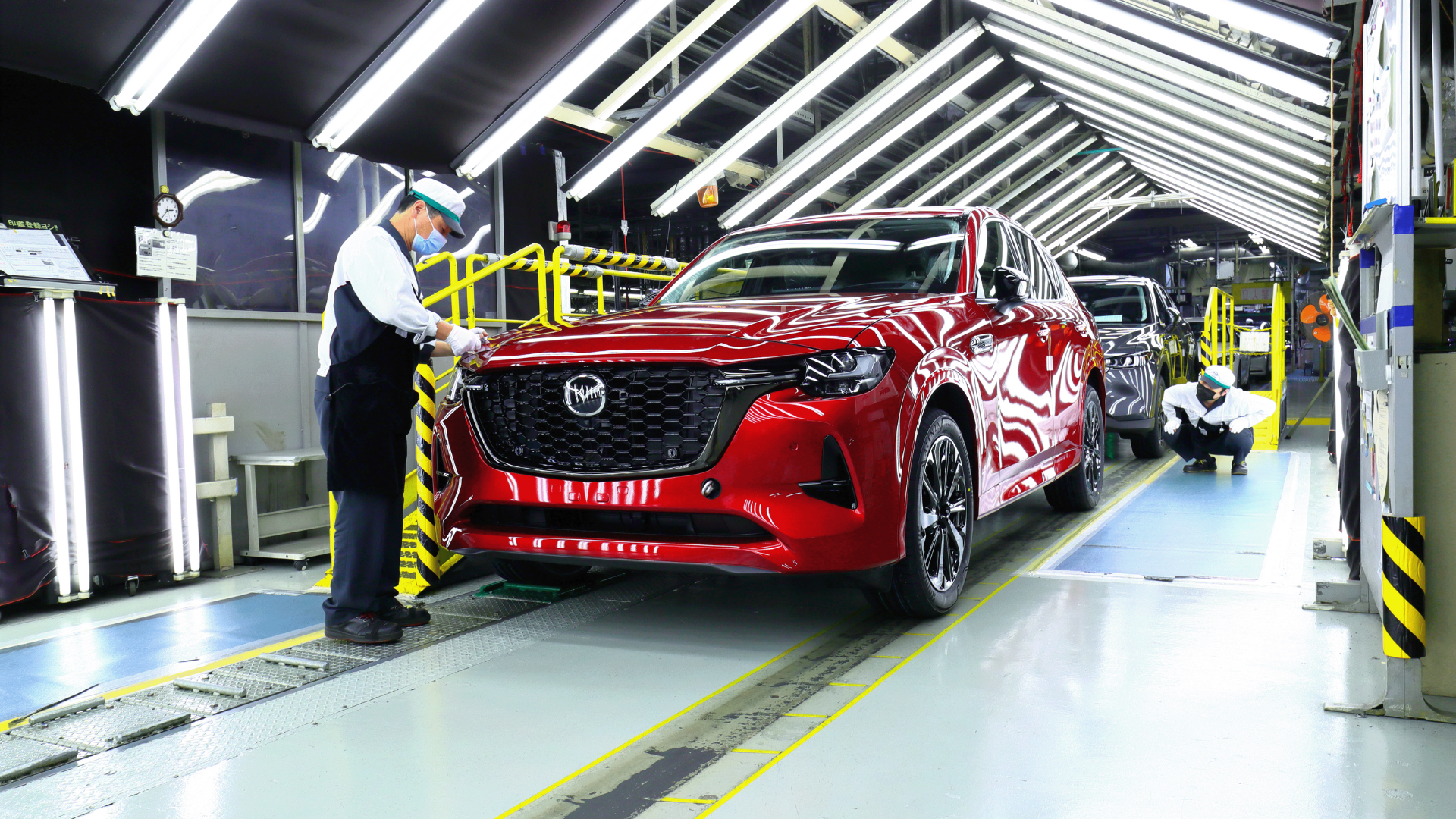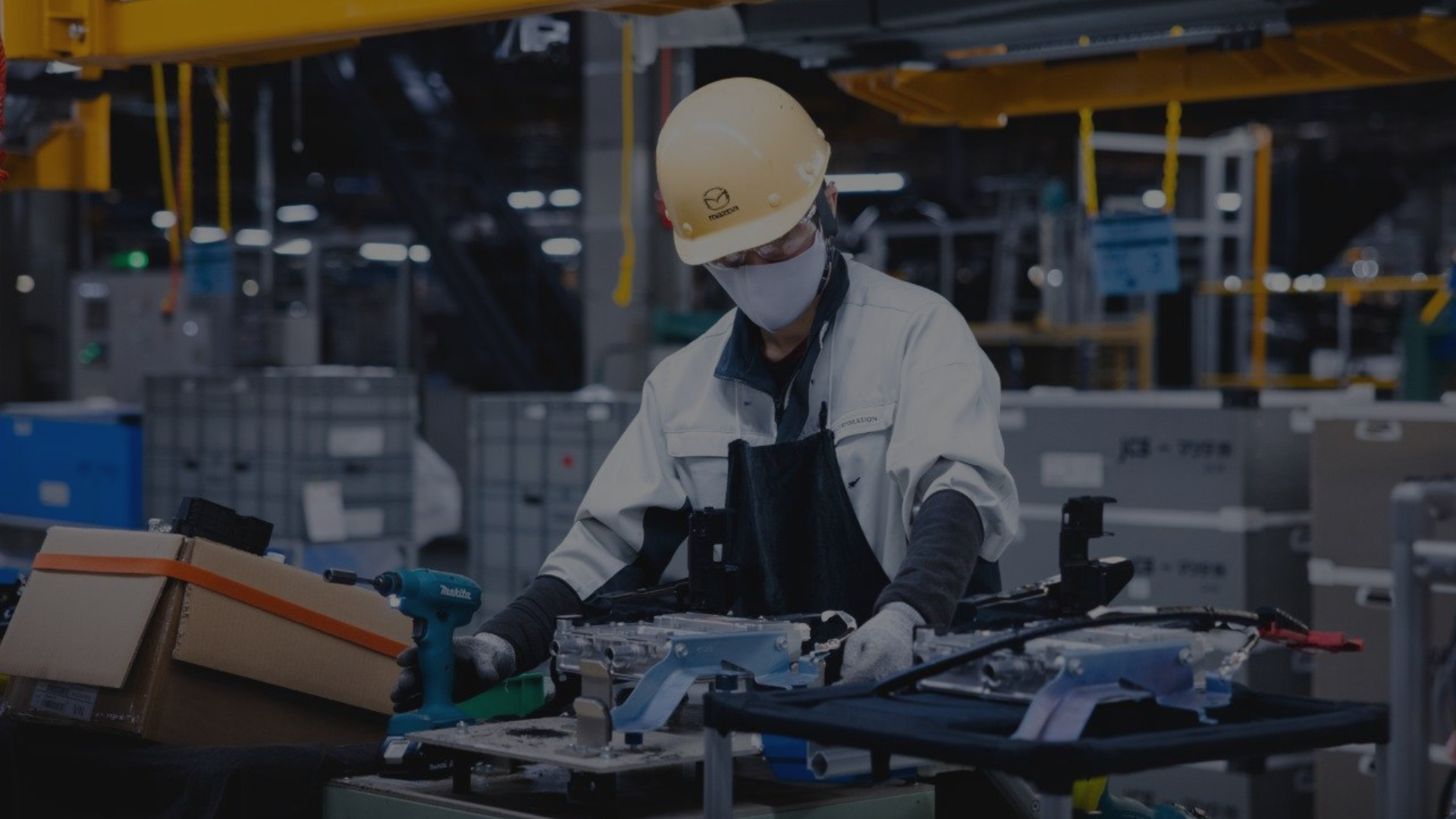Perfecting the First-Ever Mazda CX-60


When you visit a modern car factory, like the overwhelmingly enormous Mazda plant in Hofu, Japan, you expect to be blown away by the high-tech on display and the robots in particular, but there’s one thing you don’t expect to see a lot of - humans.
And yet, as we toured the factory floor where Mazda CX-60s, CX-90s and Mazda6 Sedans and Wagons were all being made, not on separate lines but simultaneously, human workers were everywhere, far outnumbering the clever, dexterous robots with their never-sleep work ethic.
Having visited many hugely automated car factories before it is initially a surprise to see so much of the magical process that is a car being created out of thousands of parts all coming together at just the right place and time being performed, in large part, by human hands.
And then it is simply mind boggling to watch, closely, what an individual human, albeit a highly trained one, can achieve.

We tend to think of a production line just pumping out one car, with one process, over and over again, but at this incredibly slick Mazda plant - and another one we visited earlier in the week at the company’s headquarters in Hiroshima - it’s all about the use of “flexible production”, which meant that we never saw two cars the same following each other down the line.
Now just consider what this means for the various people who are screwing in bolts, or attaching dashboards, aligning pieces of trim, applying the sealant for windscreens or checking the operation of convertible roofs.
At one stage in Hiroshima we watched just one man for a solid 20 minutes as he scurried from the tight confines of a soft-top MX-5 roadster, balancing himself on the line where the transmission would soon be installed, and drilling in various pieces at incredible speed, before raising the roof mechanism.
He would then approach the next car, a CX-5 SUV, and do similar and yet intrinsically different jobs in a differently shaped environment offering different challenges, all without seemingly stopping to check what each car needed him to do, before then switching to a CX-30, and then back to an MX-5, this time with a hard-top folding roof.
The only robot involved in the process is a kind of movable workbench with the various drills, tools and tiny parts that the worker might need for any one of the cars he’s working on. This automated tool kit follows the plant worker along the line, seemingly knowing where he is, so he never has to reach far for anything.
It’s incredibly impressive, and all part of what Mazda calls “mass craftsmanship”, which is about fusing human craftsmanship with cutting-edge technologies.
There’s a word for it, of course; “Monotsukuri”, which strictly speaking means “making things”, but when used by Mazda it has a wider meaning, a synthesis of prowess and the “spirit” of Japanese manufacturing processes, which means producing things with pride, skill, dedication and an overarching pursuit of perfection.
There’s a word for it, of course; “Monotsukuri”, which strictly speaking means “making things”, but when used by Mazda it has a wider meaning, a synthesis of prowess and the “spirit” of Japanese manufacturing processes, which means producing things with pride, skill, dedication and an overarching pursuit of perfection.


Norihiro Kishikawa is the General Manager of Vehicle Production at the Hofu Plant, which covers an area of 800,000 square metres, employs around 3000 workers and produces more than 400,000 cars a year.
His job means being across a vast number of processes and people and he is particularly proud of the work that the plant has put into making the First-Ever Mazda CX-60 and CX-90 - vehicles - which aim to bring a new and even higher level of premium quality to the brand - feel even more special.
Both cars are built on Mazda’s new Large Architecture Platform, and Kishikawa explains that his plant was significantly remodelled, including the body shop, paint shop and final assembly line, to “enhance customer value for CX-60 and CX-90”.
“It’s about sharing the skill of our master craftsmen with our customers and making further innovations in Mazda’s Monotsukuri innovation,” Kishikawa said.
“We are striving to manufacture in a way that creates Jinba-Ittai (the feeling of horse and rider, or car and driver, as one), so, for example, we are setting the wheel angle and the driving height with great precision, for which we introduced a high-precision all-wheel dynamics alignment tester, so that the ride height is always perfect and the car will have a high quality ride feel and follow the line of travel, exactly, when in motion.”
In some cases, this does mean using robots, for a level of perfection beyond the human eye.
“We use robots to measure the vehicle’s doors and the position of the doors - automatically adjusting the position as the bolts are tightened - to make shut lines as small as possible; on the CX-60 we have reduced them from 4mm to 3mm,” Kishikawa declares, with obvious pride.
“We’ve also created new processes that increase rigidity and improve the body frame (of CX-60 and CX-90) with enhanced strength and precision. We’ve divided the frame into a skeletal part, the frame and outer plate, and the skin parts, so we assemble the frame first and then we add the skin parts.”
As we walk along the line, it’s particularly fascinating to see the areas where robots and humans are working together. One precision robot applies silicone to windscreens, a process that looks like a cake being very precisely iced, before handing the finished versions over to two workers who install them - different sizes for each different car - with great care.
The workers are also hugely assisted by newly introduced AGVs (Automatic Guided Vehicles), which glide along the factory floor, carrying the engines, transmission and suspension for each new Mazda, before lifting them precisely into place, where two more humans take over and make the necessary fittings and attachments.
There’s a great sense of satisfaction, and some awe, to finally reach the end of the production line and to watch each Mazda, effectively, being born. The very last stage in the process, surprisingly, is a worker jumping into the front seat and attaching the steering wheel, quite a vital part of the car but not one needed until it’s ready to leave the automated line.
The worker then starts up the engine for the very first time, checks the headlights in a mirror, and drives it off the line to a holding area, from which it is shifted straight on to a truck, or a ship, to be sent to the appropriate market.
In isolation, the idea of “mass craftsmanship” might seem like a misnomer, or a marketing line, but when you see it in action, in the metal and glass flesh, it really is very impressive indeed.
And in a car like the Mazda CX-60, you can genuinely see the difference that such an incredible, and indelibly Japanese, attention to detail at every stage produces.



